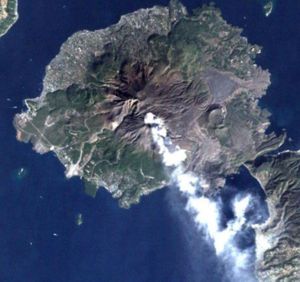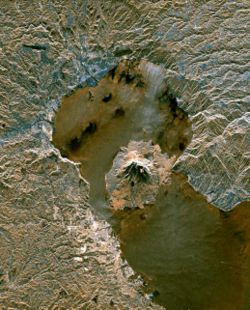Sakurajima
2007 Schools Wikipedia Selection. Related subjects: Geography of Asia
| Sakurajima | |
|---|---|
 Landsat satellite image of Sakurajima volcano |
|
| Elevation: | 1,117 m (3,665 ft) |
| Coordinates: | |
| Location: | Kyūshū, Japan |
| Type: | Stratovolcano |
| Last eruption: | Ongoing |
Sakurajima (桜島) is an active volcano and a former island (now connected to the mainland) of the same name in Kagoshima Prefecture in Kyūshū, Japan. The north peak (its highest peak) rises 1,117 m above sea level. The mountain stands in the part of Kagoshima Bay known as Nishikie Bay. The island is part of the city of Kagoshima.
In 1914, a great eruption occurred, burying the straits with lava, and connecting the former island to the Osumi Peninsula, so that Sakurajima is no longer an island. The volcanic activity still continues, dropping large amounts of volcanic ash on the surroundings. Earlier eruptions built the white sands highlands in the region.
Geological history
Sakurajima is located in the Aira caldera, formed in an enormous eruption 22,000 years ago. Several hundred cubic kilometres of ash and pumice were ejected, causing the magma chamber underneath the erupting vents to collapse. The resulting caldera is over 20 km across. Tephra fell as far as 1000 km from the volcano.
Sakurajima was formed by later activity within the caldera, beginning about 13,000 years ago. It lies about 8 km south of the centre of the caldera. Its first eruption in recorded history occurred in AD708. Most of its eruptions are strombolian, affecting only the summit areas, but larger plinian eruptions have occurred in 1471-1476, 1779-1782 and 1914.
1914 eruption
The 1914 eruption was particularly powerful, and during the eruption lava flows filled in the narrow strait between the island and the mainland, converting it into a peninsula. Before 1914, the volcano had been dormant for over a century.
The eruption began on January 11, 1914. Almost all residents had left the island in the previous days, in response to several large earthquakes which warned them that an eruption was imminent. Initially, the eruption had been very explosive, generating eruption columns and pyroclastic flows, but after a very large earthquake on January 13 which killed 35 people, it became effusive, generating a large lava flow.
Lava flows are rare in Japan—the high silica content of the magmas there mean that explosive eruptions are far more common. But the lava flows at Sakurajima continued for months. The island grew, engulfing several smaller islands nearby, and eventually becoming connected to the mainland by a narrow isthmus. Parts of Kagoshima Bay were significantly shallowed, and tides were affected, becoming higher as a result.
During the final stages of the eruption, the centre of the Aira Caldera sank by about two feet (0.6 m), due to subsidence caused by the emptying out of the underlying magma chamber. The fact that the subsidence occurred at the centre of the caldera rather than directly underneath Sakurajima showed that the volcano draws its magma from the same reservoir that fed the ancient caldera-forming eruption.
Current activity
The volcano resumed activity in 1955, and has been erupting almost constantly ever since. Thousands of small explosions occur each year, throwing ash to heights of up to a few kilometres above the mountain. The Sakurajima Volcano Observatory was set up in 1960 to monitor the eruptions, and today Sakurajima is one of the best-studied volcanoes in the world.
Monitoring of the volcano and predictions of large eruptions are particularly important because of its location in a densely populated area, with Kagoshima's 600,000 people just a few kilometres from the volcano. The city conducts regular evacuation drills, and a number of shelters have been built where people can take refuge from falling volcanic debris.
In light of the dangers it presents to nearby populations, Sakurajima was designated a Decade Volcano in 1991, identifying it as worthy of particular study as part of the United Nations' International Decade for Natural Disaster Reduction.


